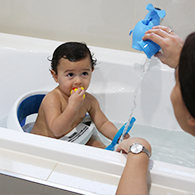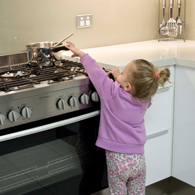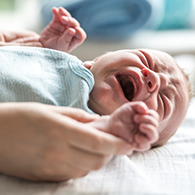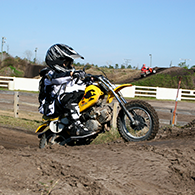Smoke alarms
What is a smoke alarm?
Smoke alarms, sometimes called “smoke detectors”, are devices that detect smoke and make a loud sound to alert people in the house to the potential danger. This is particularly important when people are sleeping as early detection of smoke gives critical seconds to escape the home.
How are children injured?
While sleeping, people generally don’t smell smoke from a fire until it’s too late. A house fire can take hold in minutes and the smoke can cause unconsciousness in a short space of time.1
Burns
- Children can be seriously burnt or die in a house fire, either from the flames or from inhaling hot air and smoke.
Poisoning
- Some modern building materials and furnishings can burn faster and produce higher levels of heat and toxic smoke. Children can be poisoned by inhaling harmful gases in smoke. Some gases, such as carbon monoxide (CO), are colourless, odourless and fatal in small doses.
Suffocation
- Smoke can kill a person long before the flames reach them. Children are more vulnerable to suffocation from the smoke produced in a house fire.
How common are these injuries?
Between 2004 and 2013, 35 children aged 0-17 years died in NSW due to fire/burns.2
- Just under half were from fires lit by children playing with matches or cigarette lighters.
- The remaining children died as a result of materials catching fire on heaters, candles, electrical issues and a chimney.
According to Fire & Rescue NSW, 56% of fatal house fires in NSW between 2002 and 2014 were in homes where there was no working smoke alarm. These house fire deaths could have been prevented if the homes had working smoke alarms and an escape plan.1
Are there laws, regulations or standards for smoke alarms?
In NSW, The Building Legislation Amendment (Smoke Alarms) Act 2005 and the Environmental Planning and Assessment Amendment (Smoke Alarms) Regulation 2006, require that all buildings where people sleep must have at least one working smoke alarm installed on each level. This includes owner occupied and rental properties, re-locatable homes (caravans and campervans) or any other residential building where people sleep. Smoke alarms must comply with the Australian Standard AS3786 – Smoke alarms using scattered light, transmitted light or ionization.
Smoke alarms can be either hard wired or battery powered.
Hard wired alarms are connected to the mains power and have a battery backup power supply. Interconnected hard wired smoke alarms make sure that if one alarm detects smoke, all the alarms will activate to alert people to the danger. Hard wired and interconnected alarms are
the recommended choice, and must be installed by a licensed electrician.
If you choose to use a battery powered smoke alarm, buy one powered by a ten year lithium battery.
As a simple guide, smoke alarms should be installed in hallways outside bedrooms. Check the Fire & Rescue NSW website for more detailed information on where smoke alarms should be located in different types of building.
Landlords are responsible for the supply and installation of smoke alarms in rental properties however tenants are responsible for the replacement of batteries in battery powered smoke alarms.
Smoke alarms should be checked and tested regularly and replaced every ten years.
For more information about smoke alarms and escape plans visit the Fire and Rescue NSW website.
Remember:
- Every home must have at least one working smoke alarm installed on each level to detect smoke. Two or more smoke alarms on each level will increase the likelihood of smoke being detected early.
- Smoke alarms must be installed according to the manufacturer’s instructions.
- Hard wired smoke alarms are recommended and must be installed by a qualified electrician.
- Smoke alarms need to be cleaned and tested regularly (at least monthly).
- Change the batteries in your smoke alarms every year. Doing this at the same time that you change your clocks for daylight saving is a great way of remembering to do this.
- Smoke alarms have a limited lifespan and should be replaced every 10 years.
- Smoke alarms are more effective if placed away from corners.
- Avoid placing smoke alarms near air conditioning and heating units or fans. Air flow from these units can obstruct the detection of smoke.
- Only use smoke alarms that meet the Australian Standard (AS3786).
- Every home should have a working fire extinguisher and/or fire blanket, within easy reach, in case of an emergency.
- Preparing and practicing an escape plan can save the lives of you and your family in the event of a fire. Windows and doors should be able to be opened quickly if needed and keys to all locked doors need to be easily accessible
- Never remove or interfere with the operation of smoke alarms in your home.
References
1 Fire and Rescue NSW http://www.fire.nsw.gov.au/
2 NSW Child Death Review Team (2014) Annual Report 2013. Sydney: NSW Ombudsman. Accessed 24/02/2016 from: https://www.ombo.nsw.gov.au/__data/assets/pdf_file/0008/19628/CDRT-Annual-Report-2013.pdf







